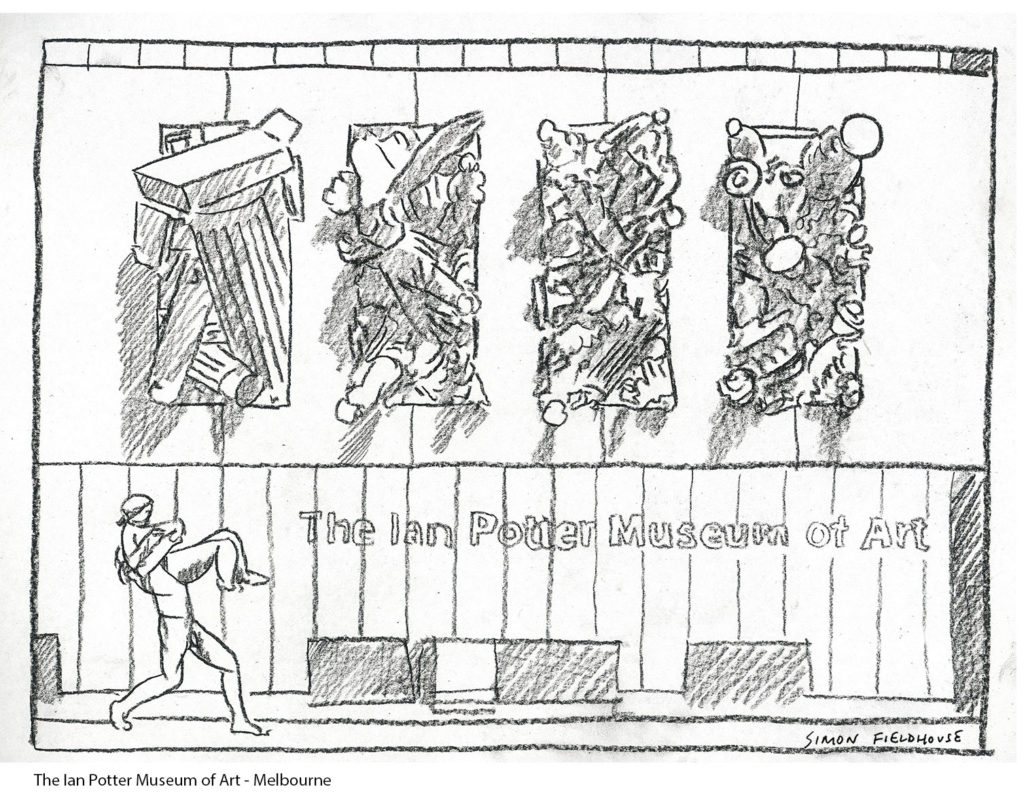
The Ian Potter Museum of Art - Melbourne - Facade Sculpture
The sculpture adorning the facade of the Ian Potter Museum of Art in Melbourne is a striking and significant element that not only enhances the building's aesthetic appeal but also conveys deeper meaning and cultural significance. The sculpture on the facade serves as an artistic prelude to the treasures housed within the museum and adds to the overall experience of visitors.
The choice of sculpture for the facade is a carefully considered aspect of the museum's design. It often reflects the values, themes, or artistic movements associated with the institution. This prominent sculpture is a visual representation of the museum's commitment to the arts and provides a glimpse into the type of art that visitors can expect to encounter inside. The selection of the sculpture is typically a result of collaboration between the museum's curators, artists, and architects, ensuring that it harmonizes with the building's design and purpose.
The sculpture on the Ian Potter Museum's facade can take on various forms, from classical and figurative to contemporary and abstract. It might symbolize specific themes, historical periods, or artistic movements, serving as an entry point for visitors to interpret the art they are about to encounter. This iconic piece often becomes a symbol of the museum itself, recognized by the community and art enthusiasts alike.
Furthermore, the sculpture on the facade can be a point of engagement and interaction with the public. It invites visitors to ponder its meaning, contemplate the relationship between art and architecture, and even start conversations about art. The sculpture can be a catalyst for intellectual and emotional exploration, setting the tone for the overall experience within the museum.
In some cases, these sculptures are periodically changed or rotated to reflect the evolving nature of art and the museum's commitment to staying current and relevant. This not only keeps the facade fresh and exciting for returning visitors but also provides an ongoing platform for artists to showcase their work and engage with the community.
Ultimately, the sculpture on the Ian Potter Museum's facade is more than just a decorative element; it is a portal to the world of art and a symbol of the institution's dedication to culture and creativity. It bridges the gap between the external and internal worlds, inviting all who approach to explore the boundless treasures within, reaffirming the museum's status as a cultural cornerstone in Melbourne.
"Cultural Rubble" is a significant and thought-provoking sculpture created by the Australian-born artist Christine O'Loughlin. This sculpture, known for its compelling and evocative design, has made its mark in the realm of contemporary art, particularly in Australia, where it has garnered recognition and critical acclaim.
Christine O'Loughlin is known for her innovative and engaging approach to sculpture, often using materials and concepts that challenge traditional notions of art. "Cultural Rubble" is a prime example of her distinctive artistic style. The sculpture is a reflection of O'Loughlin's deep engagement with the idea of cultural heritage, memory, and the passage of time.
The title, "Cultural Rubble," immediately invokes themes of decay, destruction, and the remnants of past civilizations. This suggests a reflection on the impermanence of culture and the traces that remain after societies evolve or collapse. O'Loughlin's choice of materials is integral to the sculpture's impact. Often, she utilizes discarded or repurposed materials, such as industrial remnants, to create her works. These materials speak to the idea of cultural relics, where what was once useful is now abandoned, creating a dialogue about the transience of culture and human existence.
The sculpture's form is striking, often resembling a chaotic assemblage of these materials. O'Loughlin's arrangement is deliberate, representing the fragmented nature of cultural memory and the way it can be disordered and refracted through time. The haphazard composition of the sculpture underscores the idea that culture and history are complex and multifaceted, with numerous layers, stories, and perspectives to explore.
The themes explored in "Cultural Rubble" resonate with broader discussions about heritage preservation, the impact of globalization, and the intersection of history and modernity. O'Loughlin's sculpture invites viewers to contemplate the cultural narratives that shape our identities and the significance of preserving and understanding the past.
"Cultural Rubble" has been displayed in various exhibitions and art galleries in Australia and around the world. Its presence in different contexts allows for diverse interpretations and discussions about culture, memory, and society. O'Loughlin's work has not only received critical acclaim but has also inspired many to reflect on the complex relationships between culture, history, and the objects that embody them.
In summary, Christine O'Loughlin's "Cultural Rubble" is a powerful work of contemporary art that delves into the complex themes of cultural memory, heritage, and the fragility of human civilizations. Its use of repurposed materials and its chaotic composition provoke meaningful conversations and serve as a testament to the enduring relevance of art in exploring the profound questions of our time.